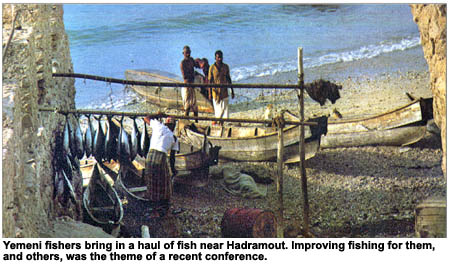
Arabs hold marine conference in Sana’a Fishing for more revenue [Archives:2002/45/Business & Economy]
November 4 2002

BY MAHYOUB AL-KAMALI
YEMEN TIMES STAFF
The Third Arab Conference on Sea Fishery was held in Sana’a Oct. 28 to 30 to find ways to protect fish wealth, exchange expertise and experiment in new ways of marketing Arab fish.
The conference comes at a time when the coasts of the governorate of Hadramout are seeing ecological catastrophe caused by oil slicks leaked from the French oil tanker Limburg, attacked on October 6. The conference has represented an opportunity for the participating delegations to be acquainted with what Yemeni waters preserve of fish reservoirs and investment opportunities available for the private sector. What has been eye-catching is the interest shown by the UN organization FAW in the conference through its regional bureau in Morocco and the centre of marketing information and consultative services for fish products in the Arab region (infosamak).
The Yemen Times has got a copy of the Commercial Bulletin issued by infosamak centre. The bulletin contains a valuable report on fish sector in Yemen that possesses more than 150 islands, some of which are populated.
Yemeni coasts length is about 2112 aerial km. Slopes and mountainous and sand terrain as well as slopes of valleys heading for the sea reach to 20% of the coast length. Thus the length of the coastal strip is more than 2500 km.
The number of villages and fishermen groupings along the shores and islands amounts to more than 90 villages and centers. The number of fishermen reaches to 41 thousand and the member of their families is estimated at 243 thousand people. The fishermen own more than 15 thousand fishing boats of various sizes and types.
Statistics point out that the total amounts of fish and marine life caught in 2000 amounted to 147 thousand tons, 92 thousand tons caught by traditional fishermen (79%), and about 23 thousand tons by using industrial fishing boats.
Infosamak report has indicated that the fish sector in Yemen is one of income making sector for its contribution to domestic product and an essential source for creating revenues, as it has occupied the second place on the list containing 30 more important exported Yemeni commodities. The fish sector is also a source of income for more than 350 thousand persons benefiting from job opportunities in this field and also for realizing the value added through activities related to services, production and marketing.
Fish wealth exploitation in Yemen is managed by two main sectors, namely, that of traditional fishermen grouped within fish societies, whose production constitutes about 79% of total annual fishing. The second sector is managed by local and foreign fishing companies for industrial and commercial fishing using big fishing boats, and this constitutes 21% of total annual fishing. A research centre for sea sciences and resources has been found in 1983 to conduct studies on fish reservoir, sea sciences and sea ecology in Yemeni regional waters. The centre researches and studies serve to help increase local production and exports. The centre conducts the following activities:
– drawing up short and long-term policies for setting up executive programs for studies and surveys,
– preparation of researches on breeding and culture of fish from selected species,
-preparation of studies on different ecological circumstances surrounding fish and marine life reproduction,
-conducting studies on sea pollution both concerning kinds and sources.
Studies have confirmed that there are more than 350 species of fish and marine life in Yemeni waters, around 60 types are being utilized. Also, there is a possibility of catching about 320 tons of bottom and surface fish and marine life.
The Yemeni government has adopted a fourth project for developing fish and most important of its phases is the building of ice factories, stores for preservation, fish auction sale halls, warehouses, offices, power generators in the cities of Hadramout and Mahrah. In addition, there is a project for improving quality of fish products and modernizing the central laboratory for watching quality of fish. The program on watching quality pays much heed for good quality of fish products and preserves their reputation abroad according to world specifications and standards. The program conducts this through the central laboratory and its affiliate centers in other governorates.
Recommendations
The conference came out with significant recommendations calling for Arab cooperation in sea fishery and working for the increase in exchange of information and expertise, besides enhancement of private sector role for investments in this vital sector. The conference also stressed the importance of developing means of fish culture and exchange of information in this respect. It urged supporting Yemen in its effort for cleaning Hadramout coasts from pollution resulted from the Limburg incident on 6 October.
——
[archive-e:45-v:2002-y:2002-d:2002-11-04-p:./2002/iss45/b&e.htm]


